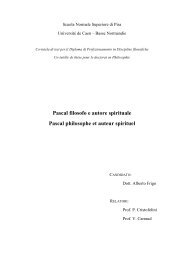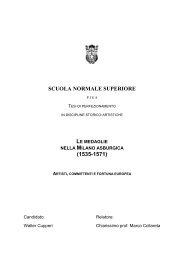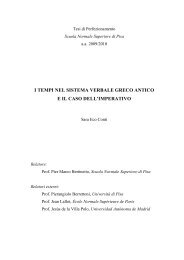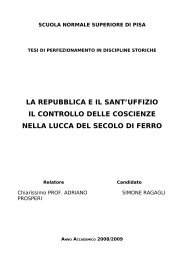CATULLUS 68 - Scuola Normale Superiore
CATULLUS 68 - Scuola Normale Superiore
CATULLUS 68 - Scuola Normale Superiore
You also want an ePaper? Increase the reach of your titles
YUMPU automatically turns print PDFs into web optimized ePapers that Google loves.
personal development alone: ‘When I was a young man…’, not ‘Five years ago…’. In short, the lament has a<br />
thoroughly subjective structure, with emotional content altering narrative regularity, and statements<br />
emphasized through repetition.<br />
Catullus’ assertion that his brother’s love nourished his pleasures in life and that after the death of his brother<br />
he banished all these joys from his mind (lines 23-26) are as startling for their introspective depth as little<br />
else in ancient literature outside his poems. As long as no source can be found from where he could have<br />
taken over such a confession, it remains the easiest to assume that he is indeed writing about his own<br />
experiences here. What he says about them is quite extraordinary. His brother’s affection and support<br />
ensured him a pleasurable love-life. It is fashionable today to see Roman sexuality as a matter of power<br />
relations, with a rich, free-born adult male using sexually a woman or a socially inferior, youthful male. Here<br />
it emerges that Catullus’ love-life is related to his social life: it is interrupted by the death of his brother not<br />
because that affected in any way his status in society (in fact, it may even have increased the value of his<br />
inheritance), but because he could find no substitute for his brother’s affection and support.<br />
15 tempore quo primum In this context the phrase cannot mean ‘when first’, which is what one would<br />
expect, as Catullus received the toga uirilis only once; it cannot mean ‘ever since’ either, which is how<br />
Quinn would render it, as Catullus’ love-life has been interrupted in the meantime; Baehrens has surely been<br />
right to paraphrase it with ubi primum, ‘as soon as’. In fact, tempore quo primum is found at the same place<br />
within the hexameter in Lucretius (5.917, meaning ‘as soon as’), Virgil (Aen. 9.80, ‘when first’) and Valerius<br />
Flaccus (2.82, ‘as soon as’). These passages are otherwise unrelated, and Kroll’s hypothesis of a lost Ennian<br />
model is attractive. That passage may have been reinterpreted by later poets in view of prose phrases such as<br />
quo tempore primum (‘as soon as’, Cic. Quinct. 46 and Clu. 162; ‘when first’, Plin. N.H. 14.97) and ab eo<br />
tempore quo primum (‘immediately from the time that’, Colum. 12.30.1). Cfr. also line 113n. tempore quo.<br />
uestis mihi tradita pura est The toga pura, libera or uirilis (of undyed light wool) was handed to an<br />
upper-class Roman youth of about 16 to mark his passage to adulthood, generally at the festival of the<br />
Liberalia on 17 March, in a ceremony where he laid down the golden bulla or amulet that had protected him<br />
during childhood and the purple-bordered toga praetextata proper to well-born children, magistrates and<br />
priests. The most detailed account of the ceremony available is still given by Marquardt (1879: 122-134); see<br />
now also Néraudau (1984: 148f. & 251-256), Eyben (1993: 6f.) and Rawson (2003: 142-145), who refers to<br />
the dissertation of Dolansky (1999), which I have been unable to consult. Among the sources note Cic. Att.<br />
5.20.9, 6.1.12 and 9.6.1. On the togae involved see Wilson (1924, esp. 51-56) and Wilson (1938: 130-132).<br />
A number of authors mark out this event as the beginning of a youngster’s sexual licence: thus also<br />
Propertius 3.15.3f. ut mihi praetexti pudor est ablatus amictus / et data libertas noscere amoris iter, Stat.<br />
Silv. 5.2.<strong>68</strong>f. quem non corrupit pubes effrena nouaeque / libertas properata togae?, Cic. Phil. 2.44 (wearing<br />
the toga praetexta, Mark Antony was bankrupt; with the toga uirilis he became a prostitute) and Pers. Sat.<br />
5.30-35 with Kißel (1990) ad loc. The change of dress must have constituted a powerful initiation ceremony,<br />
as after it the teenager would all of a sudden be recognizable from his clothes no longer as a child, but as a<br />
122






